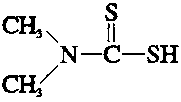|
ISO common name: |
ziram | |
|
Chemical name |
| |
|
|
IUPAC: |
zinc bis(dimethyldithiocarbamate) |
|
|
CA |
(T-4)-bis(dimethylcarbamodithioato-S,S')zinc |
|
CAS No.: |
137-30-4 | |
|
CIPAC No.: |
31 | |
|
EEC No.: |
205-288-3 | |
|
Structural formula: |
| |
|
Molecular formula: |
C6H12N2S4Zn | |
|
Molecular mass: |
305.81 | |
Physical and chemical properties
Pure active ingredient
|
Vapour pressure: |
<2.5x10-4 Pa at 25°C (Lemal, 1987) |
|
Melting point: |
246°C |
|
Octanol/water partition coefficient: |
log Pow 1.086 (Lemal and Debondue, 1984) |
|
Solubility: |
water: 18 mg/l at 20°C |
|
|
water: 10.3 mg/l (Lemal and Debondue, 1984) |
|
|
acetone: 0.8 g/l at 20°C (quoted - Wyss-Benz, 1994) |
|
|
chloroform: 6.4 g/l at 20°C (quoted - Wyss-Benz, 1994) |
|
|
petroleum ether 40-60: 21 mg/l at 20°C (quoted - Wyss-Benz, 1994) |
|
Specific gravity: |
1.66 at 25°C |
|
Hydrolysis: |
half-life at 25°C (Heasook 1995) |
|
|
10 min at pH 5 |
|
|
18 hours at pH 7 |
|
|
6.3 days at pH 9 |
|
Photolysis: |
not photosensitive |
Lemal (1987) measured the vapour pressure of ziram by a gas- saturation method. Nitrogen gas was passed through ziram coated on a support material with a very high surface area and maintained at 25°C, then through a cotton wool dust filter followed by traps containing water. The contents of the absorption traps were acidified with nitric acid and analysed for zinc by atomic absorption spectrophotometry. No zinc was detected in the traps. The vapour pressure of ziram at 25°C did not exceed 2.5x10-4 Pa.
Lemal and Debondue (1984) measured the octanol-water partition coefficient of ziram (98% phyto quality) according to OECD Guideline 107 (OECD 198 la). In a series of tests the values of log POW ranged from 0.954 to 1.196, with a median value of 1.086.
Heasook (1995) measured the rate of hydrolysis of [14C]ziram in sterile aqueous buffer solutions in the dark at pH 5, 7 and 9 and identified the products of hydrolysis.
In the rate experiments the ziram concentration was 2.8 and 2.9 mg/l and the buffer solutions contained 1% acetone to help solubility. Measurements were made for 1 hour, 72 hours and 30 days in the experiments at pH 5, 7 and 9 respectively. In the experiments designed to identify reaction products ziram concentrations were 10 mg/l and acetone was present at 3.9%.
|
Ziram half-life at 25 °C | |
|
pH 5 |
10.4 mins |
|
pH 7 |
17.7 hours |
|
pH 9 |
6.3 days |
The major hydrolysis product at pH 5 and 7 was CS2 which was also produced at pH 9. In total 11 products were observed but the short-lived ones were eventually converted to CS2 and could not be isolated and identified. Dimethyldithiocarbamic acid, carbon oxysulfide, isothiocyanic acid or thiocyanic acid and N,N-dimethylformamide were identified as hydrolysis products at pH 9.
Dimethyldithiocarbamic acid

Technical material
|
Purity: |
typically 970 g/kg |
|
Melting range: |
240-244°C |
|
Stability: |
very stable in test at 54°C for 14 days |
|
Water solubility: |
3 mg/l at 20°C (Christiaens and Verberckt, 1987) |
Christiaens and Verberckt (1987) stirred technical ziram with bi-distilled water in flasks at 30°C for 24, 48 or 72 hours. The flasks were then moved to a thermostatted bath at 20°C for 24 hours and shaken from time to time. The supernatant liquid was then centrifuged and the zinc content of the solution was measured by atomic absorption spectrophotometry. Measurements were made on 10 batches of technical ziram, with measured solubilities falling in the range 2.9-3.7 mg ziram/l (mean 3.35 mg/l). The procedure followed the OECD Guideline 105 (OECD, 1981b).
Formulations
WG 900 g/kg, WP 900 g/kg, WG 810 g/kg, WG 760 g/kg and WP 750 g/kg